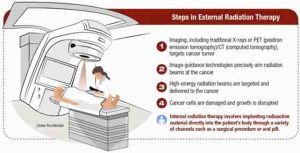Radiation therapy (also called radiotherapy) is a cancer treatment that uses high doses of radiation to kill cancer cells and shrink tumors. At low doses, radiation is used in x-rays to see inside your body, as with x-rays of your teeth or broken bones.

Different forms of external beam radiation therapy have specific effects that best suit the particular tumor. High-energy X-rays, for example, can reach deeper cancers. Advances are continually being achieved in the way that external beams “narrow in” on their target for best effect and the lowest level of risk.
Procedure
Ahead of treatment, an oncologist will decide on the dose and type of radiation. It will normally take place over the course of several sessions that are spread over a few weeks. Many people have five treatments per week. However, this can change depending on the stage and type of cancer.
A person will also undergo a CT scan before treatment to pinpoint the exact location and size of the cancer. A permanent but small ink mark will be made on the skin following the scan to ensure that the radiation is targeted accurately.
The different types of radiation therapy are administered in different ways.
In external radiation therapy, a machine called a linear accelerator is used to emit X-rays within a specific energy range.
The person receiving treatment lies on a table, and a technician based outside of the room operates the machine remotely. An intercom will be installed so that the patient and technician can communicate.
The technician will monitor the individual receiving radiation therapy through a camera.
The procedure is usually very short and painless, and a person can return home shortly after the end of the session.
Since radiation can damage normal cells, it is important that the radiation dose be targeted precisely to the cancer. Imaging also helps with treatment planning, allowing precise radiation delivery that spares surrounding, healthy tissue and minimizes side effects and complications.
An advanced form of three-dimensional (3-D) conformal radiation, called intensity modulated radiation therapy or IMRT, more precisely conforms the dose to the tumors, allowing safer delivery of higher than conventional doses of radiation. Image-guided radiation therapy or IGRT is often used in conjunction with intensity-modulated radiation therapy (IMRT) to deliver precise radiation doses to a malignant tumor or even specific areas within the tumor. Recent developments like IGRT even allow for adjustments during treatment in areas of the body that are prone to movement, such as the lungs, and tumors located close to critical organs and tissues.
Other techniques that enable ultra-precise doses of radiation to tumors include stereotactic radiosurgery, which uses 3-D imaging to determine the exact coordinates of a tumor. Other parts of the body can be treated as well, and are considered stereotactic body radiation therapy (SBRT). Emerging areas for using SBRT include lung, liver and bone.
In addition to being a treatment option for cancer, radiation therapy also is palliative; that is, it can help reduce pain and suffering in patients with advanced cancer. Patients with significant pain, trouble walking or difficulty eating because of a tumor can see an improved quality of life through palliative radiation.
Why People with Cancer Receive Radiation Therapy
Radiation therapy is used to treat cancer and ease cancer symptoms.
When used to treat cancer, radiation therapy can cure cancer, prevent it from returning, or stop or slow its growth.
When treatments are used to ease symptoms, they are known as palliative treatments. External beam radiation may shrink tumors to treat pain and other problems caused by the tumor, such as trouble breathing or loss of bowel and bladder control. Pain from cancer that has spread to the bone can be treated with systemic radiation therapy drugs called radiopharmaceuticals.
How Radiation Is Used with Other Cancer Treatments
For some people, radiation may be the only treatment you need. But, most often, you will have radiation therapy with other cancer treatments, such as surgery, chemotherapy, and immunotherapy. Radiation therapy may be given before, during, or after these other treatments to improve the chances that treatment will work. The timing of when radiation therapy is given depends on the type of cancer being treated and whether the goal of radiation therapy is to treat the cancer or ease symptoms.
